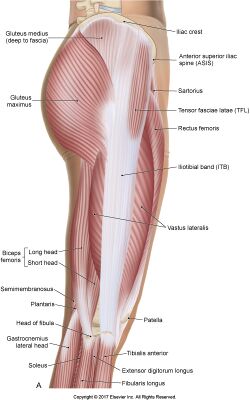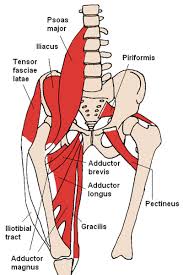Tensor Fascia Lata: Difference between revisions
No edit summary |
No edit summary |
||
| Line 2: | Line 2: | ||
== Description == | == Description == | ||
The | [[File:Iliotibial tract.jpg|right|frameless|400x400px]] | ||
The tensor fasciae latae (TFL) is a muscle of the proximal anterolateral thigh that lies between the superficial and deep fibers of the iliotibial (IT) band. There is high variability in muscle belly length, although, in most patients, the TFL muscle belly ends before the greater trochanter of the femur. | |||
* The TFL works in conjunction with the gluteus maximus, gluteus medius, and gluteus minimus in a wide variety of hip movements, including flexion, abduction, and internal rotation. | |||
* It acts via the iliotibial (IT) band's attachment to the tibia to assist with knee flexion and lateral rotation. The TFL is most important clinically for assisting in pelvis stability while standing and walking.<ref>Trammell AP, Nahian A, Pilson H. [https://www.ncbi.nlm.nih.gov/books/NBK499870/ Anatomy, Bony Pelvis and Lower Limb, Tensor Fasciae Latae Muscl]e.Available: https://www.ncbi.nlm.nih.gov/books/NBK499870/ (accessed 27.12.2021)</ref> | |||
* Image 1: TFLs position, lateral hip and thigh. | |||
== Anatomy == | == Anatomy == | ||
| Line 10: | Line 15: | ||
=== Insertion=== | === Insertion=== | ||
TFL together with the [[Gluteus Maximus|gluteus maximus]] joins to form the Iliotibial tract, which attaches to [[Tibia|lateral condyle of tibia]]<ref name=":2">Drake RL, Vogl W, Mitchell AW, Gray H. Gray's anatomy for Students 2nd ed. Philadelphia : Churchill Livingstone/Elsevier, 2010</ref><ref name=":1" /> | TFL together with the [[Gluteus Maximus|gluteus maximus]] joins to form the Iliotibial tract, which attaches to [[Tibia|lateral condyle of tibia]]<ref name=":2">Drake RL, Vogl W, Mitchell AW, Gray H. Gray's anatomy for Students 2nd ed. Philadelphia : Churchill Livingstone/Elsevier, 2010</ref><ref name=":1">Moore KL, Dalley AF, Agur AM. Clinically oriented anatomy. 7<sup>th</sup> ed. Baltimore, MD: Lippincott Williams & Wilkins, 2014</ref> | ||
The iliotibial band is a 5 cm wide band called that divides into two layers superiorly and a single tract inferiorly<ref name=":3">Miller A, Heckert KD, Davis BA.The 3-Minute Musculoskeletal & Peripheral Nerve Exam. New York: Demos Medical Publishing. 2009; p.116-117</ref>. The superficial part is attached to the tubercle of the iliac crest, and the deep lamina to the capsule of the hip joint<ref name=":3" />. | The iliotibial band is a 5 cm wide band called that divides into two layers superiorly and a single tract inferiorly<ref name=":3">Miller A, Heckert KD, Davis BA.The 3-Minute Musculoskeletal & Peripheral Nerve Exam. New York: Demos Medical Publishing. 2009; p.116-117</ref>. The superficial part is attached to the tubercle of the iliac crest, and the deep lamina to the capsule of the hip joint<ref name=":3" />. | ||
| Line 28: | Line 33: | ||
The superior gluteal vien a branch of the internal iliac viens serves as the '''venous drainage''' route. | The superior gluteal vien a branch of the internal iliac viens serves as the '''venous drainage''' route. | ||
== Function<ref name=":2" /><ref name=":1" /><ref name=":0" /> == | == Function<ref name=":2" /><ref name=":1" /><ref name=":0">Hislop HJ, Montgomery J. Daniels and Worthingham's Muscle Testing: Techniques of Manual Examination. 8<sup>th</sup> ed. Missouri: Saunders Elsevier, 2007; p201-204</ref> == | ||
[[File:Hip muscles 2.jpg|thumb]] | [[File:Hip muscles 2.jpg|thumb]] | ||
* TFL is prime mover in hip medial rotation and a weak hip abductor | * TFL is prime mover in hip medial rotation and a weak hip abductor | ||
Revision as of 23:39, 26 December 2021
Description[edit | edit source]
The tensor fasciae latae (TFL) is a muscle of the proximal anterolateral thigh that lies between the superficial and deep fibers of the iliotibial (IT) band. There is high variability in muscle belly length, although, in most patients, the TFL muscle belly ends before the greater trochanter of the femur.
- The TFL works in conjunction with the gluteus maximus, gluteus medius, and gluteus minimus in a wide variety of hip movements, including flexion, abduction, and internal rotation.
- It acts via the iliotibial (IT) band's attachment to the tibia to assist with knee flexion and lateral rotation. The TFL is most important clinically for assisting in pelvis stability while standing and walking.[1]
- Image 1: TFLs position, lateral hip and thigh.
Anatomy[edit | edit source]
Origin[edit | edit source]
TFL originates from anterior superior iliac spine(ASIS) and the anterior part of iliac crest.
Insertion[edit | edit source]
TFL together with the gluteus maximus joins to form the Iliotibial tract, which attaches to lateral condyle of tibia[2][3]
The iliotibial band is a 5 cm wide band called that divides into two layers superiorly and a single tract inferiorly[4]. The superficial part is attached to the tubercle of the iliac crest, and the deep lamina to the capsule of the hip joint[4].
Nerve Supply[edit | edit source]
The Tensor fasciae latae is innervated by superior gluteal nerve, originating from lumbar nerve 4, 5, and first sacral nerve(L4-S1) roots. It also innervates gluteus minimus and medius muscles before terminating with innervation of tensor fasciae latae muscle[3][4]
Blood Supply[2][5][edit | edit source]
Blood is supplied to TFL via deep branch of superior gluteal artery
ascending branch of the lateral circumflex femoral (LCF) artery
The superior gluteal vien a branch of the internal iliac viens serves as the venous drainage route.
Function[2][3][6][edit | edit source]
- TFL is prime mover in hip medial rotation and a weak hip abductor
- It serves as an accessory muscle/ hip synergist in abduction and flexion of the hip
- Together with gluteus maximus and the illiotibal band, it stabilizes the hip joint by holding the head of the femur in the acetabulum
- The tensor of fasciae latae, together with the gluteus maximus contributes in the stability of the knee during extension and also in partial flexion
- As part of the iliotibial tract it aids lateral rotation of the leg.
- TFL also assist in walking by inferiorly tilting the ilium on the weight-bearing side, with result in an upward tilt of the contralateral hip. Thus, allowing the leg of the non -weight bearing hip to swing through without hitting the ground during the swing phase of the gait.
Assessment[edit | edit source]
Power[6][4][edit | edit source]
The power test for the TFL is done in side-lying with hip in 45° of flexion for grade 5, 4 and 3 while for grade 2, 1 and 0, it is done in long sitting position.
The therapist is situated behind the patient with one hand is placed at the lateral surfece of the topmost thigh immediately above the knee, given downwards pressure and the other hand at the iliac crest for stability. the patient is asked to abduct against resistance.
Grade 5 is given if the patient is able to abduct and maintain position at end range against maximal resistance.
Grade 4 is given if the patient is able to abduct and maintain position at end range against moderate resistance.
Grade 3 is given if the patient is able to abduct and maintain position at end range against no resistance except gravity.
The therapist stands at the side of the limb being assessed one hand is place at the ankle serving to reduced friction between the limb and the plinth while the other hand is placed at the proximal anterolateral thigh. The patient is asked to move the limb towards the therapist.
Grade 3 is given if the patient is able to abduct to 30° and maintain position at end range.
For grade 1 and 0, the starting position is the same for grade 3 assessment but the hand placement of the therapist changes;one hand is placed at the the lateral side of the thigh immediately above the knee while the other hand is placed at the proximal anterolateral thigh for ease of TFL palpation.The patient is asked to move the limb towards the therapist.
Grade 1 is given if therapist is able to feel contraction of the muscle and grade 0 is given if no contraction is palpable.
Palpation[3][6][edit | edit source]
Palpation of TFL can be done in any of the aforementioned starting position in muscle power testing. One hand is placed at the the lateral side of the thigh immediately above the knee while the other hand is placed at the proximal anterolateral thigh and the patient is instructed to abduct(move the limb being tested away from the contralateral limb) the limb being assessed. TFL can then be easily palpable at end range of the motion.
Length[edit | edit source]
The TFL muscle is about 15cm in length[6][5].
Resources[edit | edit source]
References[edit | edit source]
- ↑ Trammell AP, Nahian A, Pilson H. Anatomy, Bony Pelvis and Lower Limb, Tensor Fasciae Latae Muscle.Available: https://www.ncbi.nlm.nih.gov/books/NBK499870/ (accessed 27.12.2021)
- ↑ 2.0 2.1 2.2 Drake RL, Vogl W, Mitchell AW, Gray H. Gray's anatomy for Students 2nd ed. Philadelphia : Churchill Livingstone/Elsevier, 2010
- ↑ 3.0 3.1 3.2 3.3 Moore KL, Dalley AF, Agur AM. Clinically oriented anatomy. 7th ed. Baltimore, MD: Lippincott Williams & Wilkins, 2014
- ↑ 4.0 4.1 4.2 4.3 Miller A, Heckert KD, Davis BA.The 3-Minute Musculoskeletal & Peripheral Nerve Exam. New York: Demos Medical Publishing. 2009; p.116-117
- ↑ 5.0 5.1 Hubmer MG, Schwaiger N, Windisch G, Feigl G, Koch H, Haas, FM, Justich I, Scharnagl E. The vascular anatomy of the tensor fasciae latae perforator flap. Plastic Reconstructive Surgery: 2009;124(1):181-9. Doi: 10.1097/PRS.0b013e3181ab114c. PMID:19568071
- ↑ 6.0 6.1 6.2 6.3 Hislop HJ, Montgomery J. Daniels and Worthingham's Muscle Testing: Techniques of Manual Examination. 8th ed. Missouri: Saunders Elsevier, 2007; p201-204









